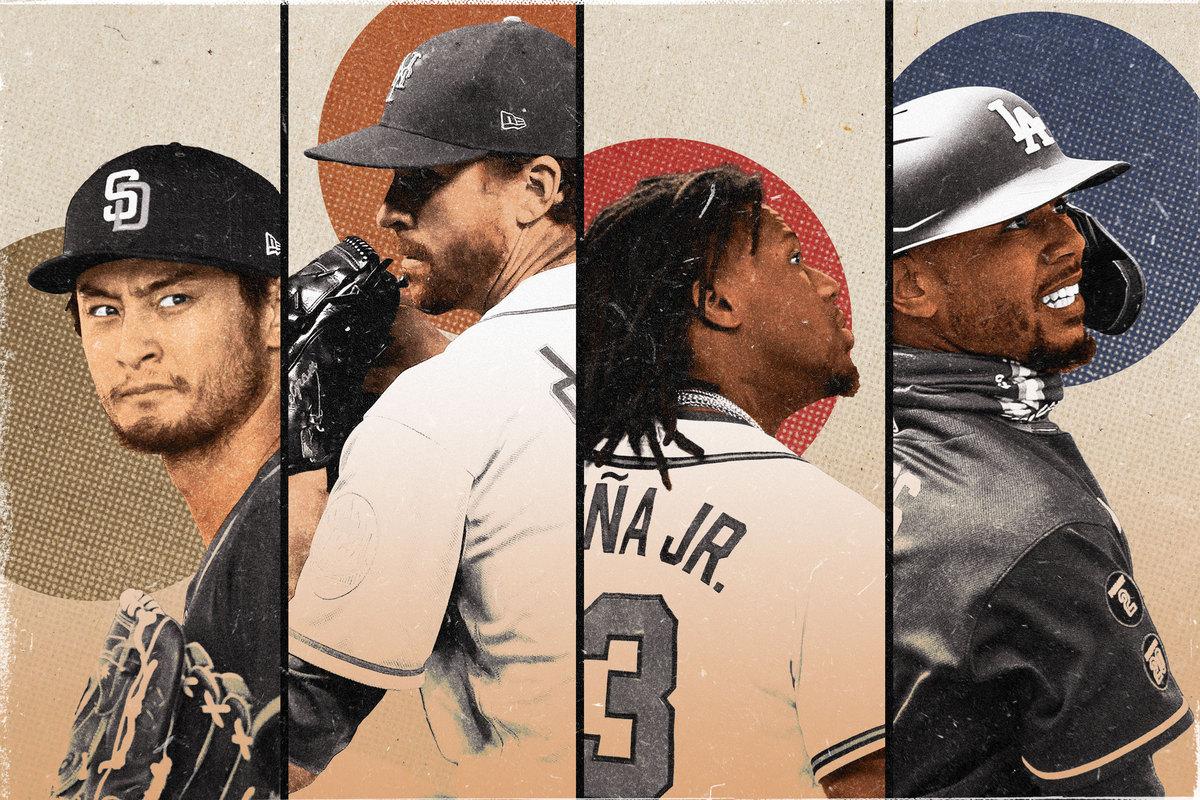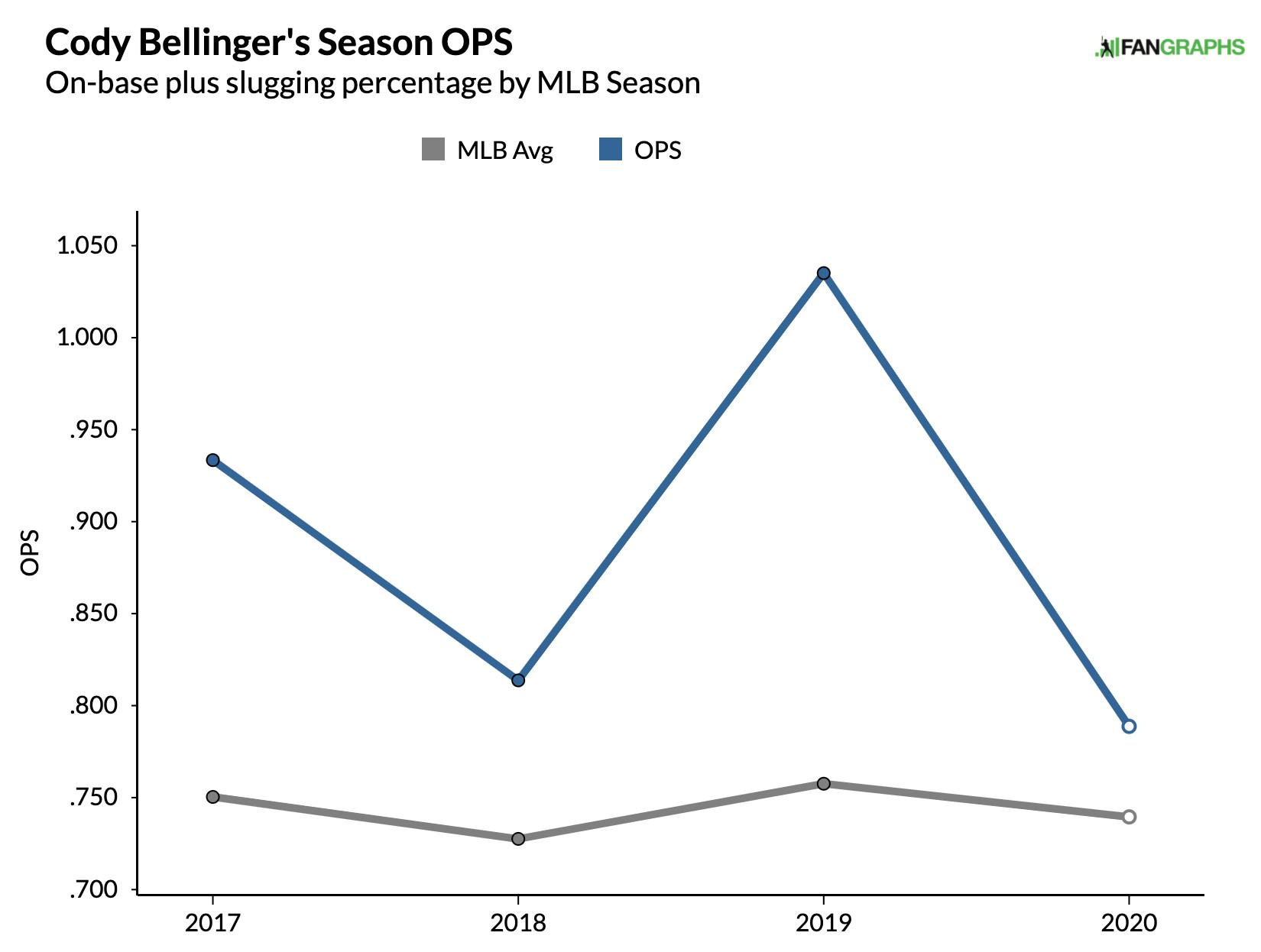
Typically, when discussing “X Team(s) or the field?”–style questions, we’re speculating about the actual future. As in, would you take the Dodgers and Padres over the rest of the National League right now, when predicting which team will represent the senior circuit in the 2021 World Series?
The field is almost always the right answer, for sheer quantity alone; in this case, it’s 13 teams versus two! But these aren’t just any two teams—they’re the two best teams in the majors, by both 2020 run differential and, after an offseason of flurried activity, 2021 projected record. Indeed, according to current FanGraphs playoff odds, the Dodgers (32 percent) and Padres (21) combine for a 53 percent pennant probability, slightly ahead of the rest of the National League’s 47 percent combined odds.
But today, we will apply the “Dodgers and Padres vs. the rest of the NL” framing a bit differently: Those two West powers have so many stars that we’re wondering, Could a hypothetical combined Dodgers-Padres roster beat an all-star roster built from every other NL team?
First, some ground rules: Because we’re thinking about the stars, we will assume perfect health, taking FanGraphs’ 2021 WAR projections for each player and prorating to 162 games for position players and 32 starts for pitchers. That means no need for a bench.
We also won’t include bullpens, because I frankly don’t trust individual reliever projections after a shortened season, with so many key relievers—like Drew Pomeranz, the Padres’ relief ace and maybe the best bullpen arm in the entire National League—converting recently from the rotation. Anyhow, both the Padres’ and Dodgers’ bullpens project well on a team level and their combined roster would have plenty of worthy starters left over to fill an elite bullpen, so we’ll call the pens even.
Lastly, All-Star Game rules don’t apply: The NL All-Stars can stack their team with as many players from New York and Atlanta as they want without worrying about including a Pirate or Marlin. We want the best against the best here.
We’ll go position by position to compare the two rosters, the combined rest-of-the-NL’s on one side, the combined Dodgers-Padres’ on the other. Actually, you know what? That latter group needs a better name: We’ll go with Podres, both as a homonym for the San Diego team’s nickname and in honor of Dodgers great Johnny Podres, whose Game 7 shutout against the much-despised Yankees in 1955 brought the then-Brooklyn Dodgers their first World Series title.
Catcher
Will Smith vs. J.T. Realmuto (Philadelphia)
Position WAR: 3.4 for the Podres vs. 4.5 for the NL All-Stars
Total: 3.4 vs. 4.5
Realmuto is the best catcher right now; L.A.’s Smith is the best catcher of the future, projected to take over the position’s lead in WAR by 2023. For the present, though, Realmuto gives the NL All-Stars a lead from the start, because projection systems have to assume that in a larger sample, Smith will regress from being literally the best-hitting catcher in MLB history, one spot ahead of Mike Piazza.
First Base
Max Muncy vs. Freddie Freeman (Atlanta)
Position WAR: 3.0 vs. 4.6
Total: 6.4 vs. 9.1
Spoiler alert: Catcher and first base are the two worst positions by 2021 projected WAR for the Podres, so the NL All-Stars are well ahead in the early going. Muncy has been one of the majors’ best hitters since joining the Dodgers, but he’s not much of a match for the reigning NL MVP. This is the one and only position in this exercise in which I am confident that the Podres’ representative will perform worse than the NL All-Stars’ in 2021.
Second Base
Corey Seager vs. Ozzie Albies (Atlanta)
Position WAR: 5.8 vs. 4.2
Total: 12.2 vs. 13.3
We’re cheating just a smidge here, as Seager has never played second base in the majors or minors. But on this combined roster, he’ll slide over to second to make way for his star teammates on the other side of the infield, like in the 2017 World Baseball Classic when Team Puerto Rico played Carlos Correa at third base and Javier Báez at second to accommodate Francisco Lindor at short.
A year ago, that sort of shuffling might not have been warranted—but Seager enjoyed a much-needed bounce-back season in 2020, after he lost most of 2018 to an elbow injury and 2019 to a slump. In those two seasons, he ranked just 12th among shortstops in performance at the plate (.271/.337/.468), in a near-tie with fellow Dodger Chris Taylor, who’s a solid player but far from a star. In 2020, Seager ranked second with a .307/.358/.585 line, then followed with a .328/.425/.746 line throughout a postseason that ended with MVP awards in both the NLCS and World Series. His soon-to-be-discussed Podres teammate is the only shortstop in the majors with a better 2021 projection.
On the NL All-Stars’ side, Arizona’s Ketel Marte is about half a win shy of Albies—a notable comparison only because this is the closest any NL West team other than the Padres and Dodgers comes to rostering a player here. The separation between the top two and bottom three teams in that division will be massive.
Third Base
Manny Machado vs. Nolan Arenado (St. Louis)
Position WAR: 4.5 vs. 4.2
Total: 16.7 vs. 17.5
Well, I suppose the NL West would have had a representative if the Rockies hadn’t traded Arenado. (Sorry, Coloradan readers.)
Machado is the Podres’ only player who has spent time with both the Dodgers and Padres, as he signed with San Diego in free agency after a half-season stint with L.A. in 2018. He finished third in NL MVP voting in 2020 and, at 28 years old, is a likely Hall of Famer in his prime. He also would hit something like sixth in the Podres’ lineup because his teammates are so superb.
Shortstop
Fernando Tatis Jr. vs. Francisco Lindor (New York)
Position WAR: 6.0 vs. 5.2
Total: 22.7 vs. 22.7
First things first: This positional matchup wins the award for best vibes.
Assuming perfect health might benefit Tatis more than any other player in this exercise, as he missed extended stretches in both 2018 (in the minor leagues) and 2019 with injuries. He stayed healthy through the shortened 2020 season, but then was removed from a spring training game just this week due to shoulder discomfort.
Still, Tatis would have the best projection for any shortstop even without a 162-game proration. That’s how special he’s been in his MLB career thus far—as good a hitter through age 21 as Ty Cobb and Rogers Hornsby, with more outs above average last season than any other shortstop in the majors.
Lindor, of course, is no slouch either, and will now help pace a loaded group of NL shortstops. (See also: Trea Turner, Trevor Story, Javier Báez if he remembers how to hit.) That Tatis projects for nearly a win better than the established star is a testament to just how much we can expect from the face of the Padres’ franchise, and for this article’s purposes, the infield trio of Seager, Machado, and Tatis completely erases the NL All-Stars’ early WAR lead. Five positions in, the two rosters are perfectly tied.
Left Field
Trent Grisham vs. Christian Yelich (Milwaukee)
Position WAR: 3.7 vs. 4.5
Total: 26.4 vs. 27.2
Grisham played exclusively center field for San Diego last season, when he won a Gold Glove, but he split time nearly evenly across the three outfield positions for Milwaukee in 2019 before his trade to the Padres. And with two other Gold Glove outfielders waiting in the Podres’ lineup, Grisham shifts over to left on the combined roster.
Why is it so important to slot Grisham in the lineup? Here’s a fun fact: Only four players age 23 or younger last season produced at least 2 WAR, by either FanGraphs’ or Baseball-Reference’s reckoning: Tatis, Ronald Acuña Jr., Juan Soto, and Grisham, easily the least heralded member of that quartet.
Yet even in a shortened season, every statistical indicator suggests future stardom for the young outfielder, even if he doesn’t reach the same level as Tatis, Acuña, or Soto. Grisham ranked in the 96th percentile in sprint speed and tied for third among outfielders in outs above average, he’s always exhibited strong walk rates, and he was one of just six players with double-digit home runs and steals. Look at how his 2020 season compares to that of Luis Robert, who’s just a year younger than Grisham and receives much more hype despite much worse results at the plate. (Both are fantastic defenders.)
Trent Grisham vs. Luis Robert in 2020
Grisham projects about a win shy of Yelich this season, because 60 games of lackluster performance aren’t enough to wipe away the latter’s previous two seasons of MVP-worthy play. Thus, the NL All-Stars regain the lead—but not by nearly as much as anyone would have expected in a comparison of Yelich and Grisham, his teammate for a short time, a year ago.
Center Field
Cody Bellinger vs. Ronald Acuña Jr. (Atlanta)
Position WAR: 5.8 vs. 5.9
Total: 32.2 vs. 33.1
Thus far in his career, Bellinger has alternated award-winning seasons (Rookie of the Year in 2017, MVP in 2019) with less impressive campaigns at the plate.

Of course, even in his down years, he’s still an above-average hitter with phenomenal speed and defense, and this every-other-year pattern suggests he’s due for a dynamite 2021. It wouldn’t register as a shock if either Bellinger or Acuña won the NL MVP this year.
Right Field
Mookie Betts vs. Juan Soto (Washington)
Position WAR: 6.4 vs. 6.2
Total: 38.6 vs. 39.3
Even more than Bellinger and Acuña, Betts and Soto may be the NL’s two likeliest MVP candidates this season, and with Soto now in right field after spending most of his young career in left, they form a fitting pair to round out the starting lineups. And look how close the total WAR counts are at this point: The Podres’ lineup is within a single win—certainly within the margin of error for this stat—of the best the rest of the NL has to offer.
Starting Pitchers
Now, on to the pitchers. To build tension, we’ll count in reverse order, from the back of the rotation to the front.
5. Dinelson Lamet vs. Luis Castillo (Cincinnati)
Position WAR: 3.8 vs. 4.3
Total: 42.4 vs. 43.6
So great is the Podres’ stable of pitchers that offseason additions Joe Musgrove (3.6 projected WAR over 32 starts) and Blake Snell (3.7) don’t qualify for the rotation. Instead, by a fraction, the fifth spot goes to Lamet, who had a legitimate Cy Young case with a 2.09 ERA last season but hurt his elbow in his final start. There’s a reason the Padres, who have all three of these pitchers, rank no. 1 in the majors in projected starting pitching WAR.
4. Clayton Kershaw vs. Aaron Nola (Philadelphia)
Position WAR: 4.2 vs. 4.3
Total: 46.6 vs. 47.9
After seven consecutive top-five Cy Young finishes, Kershaw hasn’t finished that high once in three seasons since turning 30. Yet in that span, he still ranks fifth among starters (minimum 200 innings) with a 2.78 ERA, plus now he’s exorcised his World Series demons. And the Podres are so stacked that he’s their no. 4 starter. There’s a reason that the Dodgers rank no. 2 in the majors in projected starting pitching WAR.
3. Yu Darvish vs. Stephen Strasburg (Washington)
Position WAR: 4.3 vs. 4.6
Total: 50.9 vs. 52.5
The Podres’ no. 3 through 7 starters (the top five plus Snell and Musgrove) are all essentially equals to the no. 3 through 7 starters for every other NL team combined. No matter how many times I repeat some variation of that sentence, it still strikes me as ridiculous.
Up against the might of the NL All-Stars, Lamet, Kershaw, and Darvish have all lost to their counterparts by a fraction of a win, slightly widening the gap between these two rosters. Yet, with just two pitchers to go, the Podres are still well within striking distance.
2. Trevor Bauer vs. Max Scherzer (Washington)
Position WAR: 4.5 vs. 5.3
Total: 55.4 vs. 57.8
Bauer’s presence on the Podres is the greatest sign of the arms race at the top of the NL West this offseason. The Padres brought in Darvish, Snell, and Musgrove, so the Dodgers, despite an already stuffed staff, added last year’s NL Cy Young winner. Of the five best-projected pitchers to change teams this winter, the Padres and Dodgers nabbed four of them. (The fifth, Charlie Morton, went to Atlanta.)
But like Yelich in the lineup, Scherzer boasts a robust projection; his track record is sufficiently strong to compensate for an off season in a 60-game schedule. The distance between the Podres and NL All-Stars grows—and the latter’s greatest weapon is ready to arrive, saving the best for last.
1. Walker Buehler vs. Jacob deGrom (New York)
Position WAR: 4.6 vs. 6.3
Total: 60.0 vs. 64.1
Here, we find the greatest WAR difference for any position in this exercise—even more than Freeman over Muncy or Seager over Albies—as the Podres run out of steam at the close. That’s not a knock against Buehler, but speaks more to the overwhelming dominance that deGrom—who is somehow still adding miles per hour to his fastball—has displayed through the past three years. The Mets ace won two Cy Youngs and might have had a third in a row if not for the strange 2020 schedule, which allowed Bauer and runner-up Darvish to pad their stats against the dregs of the Central divisions.
The final WAR sum places the NL All-Stars in the lead; the answer to this goofy hypothetical is that the combined Dodgers-Padres roster, with eight Dodgers and five Padres to reflect the Dodgers’ status as favorites, loses to the field. But the difference isn’t all that profound, and given the haziness of projections, especially after the shortened season, it’s still quite possible that the Podres’ stars outperform the rest of the National League on the field this season.
Even in this hypothetical, they’re still close. Using those WAR totals and a win probability formula, we’d estimate that in a single game between these two teams, the Podres would have a 47 percent chance to win; in a seven-game series, they’d have about a 43 percent chance to emerge victorious. The field is favored, but not by much. There’s a reason we’re so excited about the Dodgers and Padres this year.

